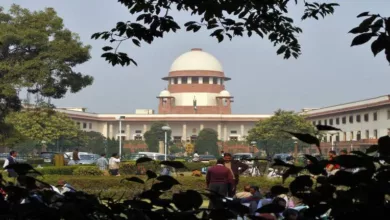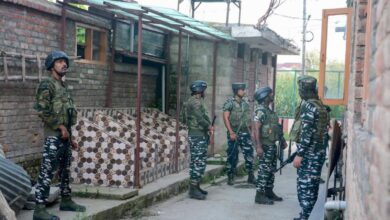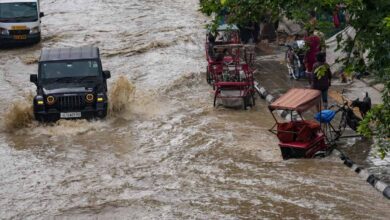Delhi govt issues flood warning after Haryana discharges over 1 lakh cusecs of water into Yamuna from Hathnikund barrage

Delhi govt issues flood warning after Haryana discharges over 1 lakh cusecs of water into Yamuna from Hathnikund barrage
On Sunday, the Delhi government issued a flood warning due to the discharge of over one lakh cusecs of water into the Yamuna River from the HathniKund Barrage in Yamunanagar, Haryana.
The Irrigation and Flood Control Department of Delhi stated that this release of water prompted the issuance of the first flood warning. At 4 pm, a total of 1,05,453 cusecs of water was released into the Yamuna River from the Hathnikund barrage.

The flood warning highlights the potential risk of flooding in low-lying areas along the Yamuna River in Delhi. Authorities are likely to monitor the water levels closely and take necessary measures to ensure the safety of residents and minimize damage caused by potential flooding.
It is essential for residents in flood-prone areas to stay updated with official announcements and follow the instructions provided by local authorities. Taking necessary precautions, such as evacuating if required and avoiding areas prone to flooding, can help ensure personal safety.
In response to the flood warning and the rising water levels in the Yamuna River, officials have been directed to stay vigilant and take appropriate measures to address the situation. These measures may include monitoring vulnerable areas, implementing flood control measures, and deploying quick response teams to raise awareness among residents residing within the river embankments.
The Central Water Commission (CWC) issued a warning stating that the water level in the Yamuna River in Delhi is rising and is projected to exceed the danger mark of 205.33 meters on Tuesday. This highlights the potential risk of flooding in low-lying areas along the river.
Authorities and disaster management agencies are likely to work in coordination to prepare for potential flooding and ensure the safety of residents. Communication channels and warning systems will be utilized to keep the public informed about the evolving situation and the necessary precautions to be taken.
It is crucial for individuals residing in flood-prone areas along the Yamuna River to stay alert, follow the instructions of local authorities, and take necessary actions to ensure their safety. This may involve relocating to safer areas, securing personal belongings, and preparing for evacuation if required.

By remaining vigilant and adhering to the guidance of official sources, individuals and communities can mitigate the risks associated with flooding and ensure the well-being of themselves and their loved ones.According to the flood-monitoring portal of the Central Water Commission (CWC), the water level in the Yamuna River at the Old Railway Bridge in Delhi was recorded at 203.18 meters at 1 pm on Sunday. The warning level for the river is set at 204.5 meters.
As per the CWC’s advisory, the water level is expected to rise further and reach 205.5 meters between 11 am and 1 pm on Tuesday. This projection indicates that the water level will surpass the warning level, increasing the risk of potential flooding in low-lying areas along the Yamuna River.
The advisory from the CWC serves as an important early warning, allowing authorities and residents to prepare for the rising water levels and take necessary precautions to minimize the impact of potential flooding.
Local authorities and disaster management agencies are likely to continue monitoring the situation closely and implement appropriate measures to ensure the safety of residents. It is crucial for individuals living in flood-prone areas to stay updated with the latest information from official sources and follow the instructions provided by local authorities.
Taking necessary precautions, such as relocating to higher ground if required, securing personal belongings, and being prepared for evacuation, can help mitigate the risks associated with flooding. Residents should also avoid venturing into floodwaters and stay away from the riverbanks during this time.
By staying informed and prepared, individuals and communities can effectively respond to changing water levels and ensure their safety in the event of a flood.Over the past two days, northwest India has been experiencing relentless rainfall, leading to significant consequences in various states. Uttarakhand, Himachal Pradesh, Haryana, Uttar Pradesh, and Rajasthan have witnessed heavy to very heavy precipitation, resulting in overflowing rivers, creeks, and drains. This has caused extensive damage to infrastructure and disrupted essential services in Jammu and Kashmir, Himachal Pradesh, and Uttarakhand.
The national capital, Delhi, recorded a staggering 153 mm of rainfall in 24 hours ending at 8:30 am on Sunday. This was the highest single-day rainfall recorded in July since 1982. Similarly, Chandigarh and Ambala in Punjab also experienced record-breaking rainfall, with measurements of 322.2 mm and 224.1 mm, respectively, as reported by the India Meteorological Department (IMD).
The incessant downpour has resulted in several immediate impacts. Rivers, creeks, and drains have overflowed, leading to waterlogging in many areas. This has caused transportation and daily life disruptions, with roads and streets being inundated. In some instances, vehicles have been stranded or submerged, making it difficult for people to move around. The heavy rains have also triggered landslides, further exacerbating the challenges faced by the affected regions.
The torrential rainfall has severely affected the infrastructure in Jammu and Kashmir, Himachal Pradesh, and Uttarakhand. Bridges, roads, and other critical infrastructure have suffered damage, hampering connectivity and posing risks to public safety. Power supply has been disrupted in various areas, causing inconvenience to residents. Water supply schemes have also been affected, leading to a shortage of clean water in some places.
The impact of the heavy rainfall extends beyond physical infrastructure. Agricultural activities have been severely affected, with standing crops getting damaged and farmers facing significant losses. The incessant rains have also raised concerns about potential damage to livestock and the overall agricultural economy of the affected regions.
Authorities and disaster management agencies have been working tirelessly to address the situation. Rescue and relief operations are underway to evacuate stranded individuals and provide them with the necessary support.
Efforts are being made to restore connectivity by clearing blocked roads and repairing damaged infrastructure. Power restoration teams are working to ensure the electricity supply is resumed quickly. Steps are also being taken to provide temporary shelter and relief materials to those affected by the heavy rains.
The India Meteorological Department (IMD) continues to monitor the weather conditions and issue warnings to the affected regions. The IMD’s forecasts and early warnings are crucial for ensuring the safety of residents and enabling authorities to take preventive measures.
The challenges posed by the incessant rainfall and its aftermath highlight the need for continued preparedness and resilience in dealing with extreme weather events. It is essential for authorities, communities, and individuals to work together to mitigate risks, implement effective disaster management strategies, and ensure the safety and well-being of everyone affected by such natural calamities.
In conclusion, the recent heavy rainfall in northwest India has caused significant disruptions, damaging infrastructure and disrupting essential services. Immediate measures are being taken to address the situation and relieve affected individuals. Long-term efforts are required to strengthen preparedness and resilience in the face of extreme weather events, emphasizing the importance of collaboration and proactive planning to mitigate the impacts of such events in the future. The Yamuna river system’s catchment area spans several states in north India, including Uttar Pradesh, Uttarakhand, Himachal Pradesh, Haryana, Rajasthan, Madhya Pradesh, and Delhi.
These regions contribute to the water flow into the Yamuna River, making it a significant river system in the area.
Among the areas located along the Yamuna River in Delhi, the low-lying regions are particularly vulnerable to flooding. These areas are prone to waterlogging and face a higher risk of inundation during periods of heavy rainfall or when the river water levels rise significantly. It is estimated that around 37,000 people reside in these low-lying areas along the river in Delhi.
The vulnerability of these areas to flooding highlights the importance of implementing measures to mitigate the impact of such events. Local authorities, disaster management agencies, and concerned stakeholders must prioritize infrastructure development, including improved drainage systems and flood protection measures, to safeguard the residents in these vulnerable areas.

Additionally, early warning systems, evacuation plans, and community awareness programs play a crucial role in ensuring the safety and well-being of the people residing near the Yamuna River in Delhi. By being prepared and informed, residents can take necessary precautions during periods of increased flood risk.
Efforts are also required to promote sustainable urban planning and development practices considering flood resilience. This includes avoiding construction in flood-prone areas and implementing measures to improve water management and flood control within the city.
Overall, recognizing the vulnerability of low-lying areas near the Yamuna River in Delhi and taking proactive measures to address flood risks are essential for protecting the lives and property of the residents. By implementing appropriate infrastructure, fostering community preparedness, and adopting sustainable development practices, flooding can be minimized, ensuring a safer and more resilient living environment for those residing along the river.






